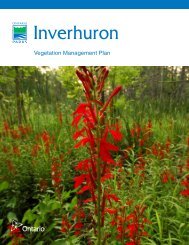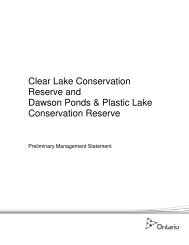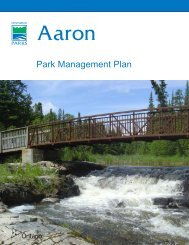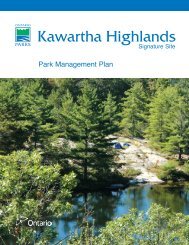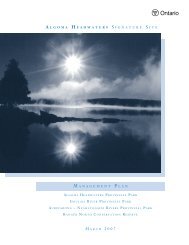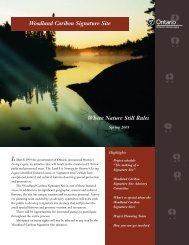Sandbanks Draft Veg Mgmt Plan - Ontario Parks
Sandbanks Draft Veg Mgmt Plan - Ontario Parks
Sandbanks Draft Veg Mgmt Plan - Ontario Parks
Create successful ePaper yourself
Turn your PDF publications into a flip-book with our unique Google optimized e-Paper software.
IMPLEMENTATION SCHEDULE G – Restoration Implementation <strong>Plan</strong><br />
fall<br />
More difficult to plant (roots often curved, not<br />
packed in tightly, holes not big enough,<br />
incorrect depth)<br />
Use only when planting with experienced staff<br />
Easy to plant correctly<br />
Use when planting with volunteers<br />
<strong>Plan</strong>ting <strong>Plan</strong><br />
• Stake out planting locations beforehand, using the nucleation or matrix method.<br />
Nucleation • Establishment of nucleation clumps is a priority over the matrix plantings<br />
as these will help seed the matrix areas and create uneven-aged stands.<br />
• Clumps should be placed on the mounds and be large enough to create<br />
an enhanced microclimate (10-15 trees at 3m spacing).<br />
• Trees should be caliper size as these establish quicker, have more<br />
visual impact, more drought tolerance, and are less susceptible to<br />
herbivory and competition.<br />
• Shrubs should be planted in small groupings of 3 to 5 plants between the<br />
trees with 1m spacing (approximately a shovel length).<br />
Matrix • Matrix plantings will help fill out the canopy.<br />
• Distribute plants throughout the restoration area at a spacing of 1.5m to<br />
create a natural looking forest. These should not be in rows<br />
• Trees should be 2-4L pot size (~1m tall) or tall bareroot “whips” to<br />
provide a balance between cost and adequate presence.<br />
• All woody species plantings should be conducted before June (preferred) or after August<br />
(if necessary) to allow maximum establishment and growth of the plants and minimize<br />
stress on them.<br />
• Water all trees and shrubs prior to planting to ensure adequate moisture for<br />
establishment.<br />
• All plantings should have plastic tubing placed around the lower stem to reduce small<br />
mammal damage and make it easier to locate plantings for future monitoring.<br />
• Wood chip mulch should be applied in a donut-shaped mound around each planting to<br />
decrease competing vegetation and help to hold moisture in the soil.<br />
• Continuing care of the restoration site will be required in the first year or two, including<br />
the following (can use volunteers):<br />
• Monitor for severe drought conditions that may require supplemental watering in July<br />
• Check for extensive deer browse damage that may require treatment (eg. deer<br />
sprays, altered species list, etc)<br />
• Cut any extensive growth of competing vegetation away from the plantings – may<br />
require addition of extra mulch in future years<br />
• Mechanically remove new invasive species from the site<br />
• Remove protective tubing as the trees outgrow them<br />
Volunteer Involvement<br />
<strong>Plan</strong>ting events are an excellent opportunity to involve volunteers in restoring the landscape.<br />
Knowledgeable staff will be required to train and supervise volunteers to ensure quality<br />
control. Some considerations when working with the volunteers are outlined below.<br />
• Provide an overview of the purpose of restoration including anticipated successional<br />
changes.<br />
<strong>Sandbanks</strong> <strong>Veg</strong>etation Management <strong>Plan</strong> A-27<br />
<strong>Ontario</strong> <strong>Parks</strong>, SE Zone<br />
2009





